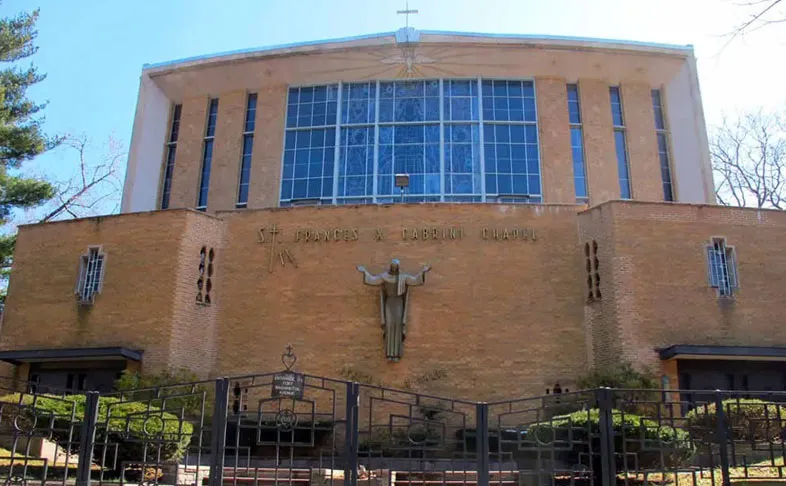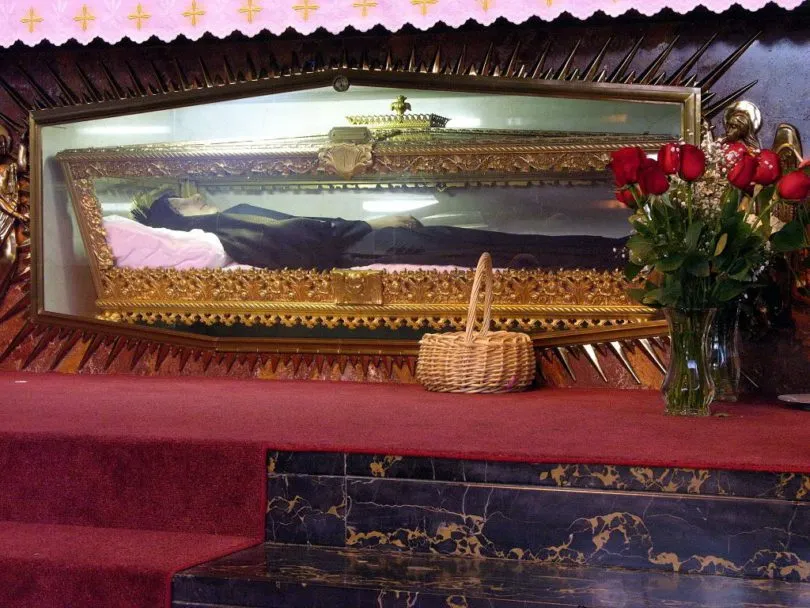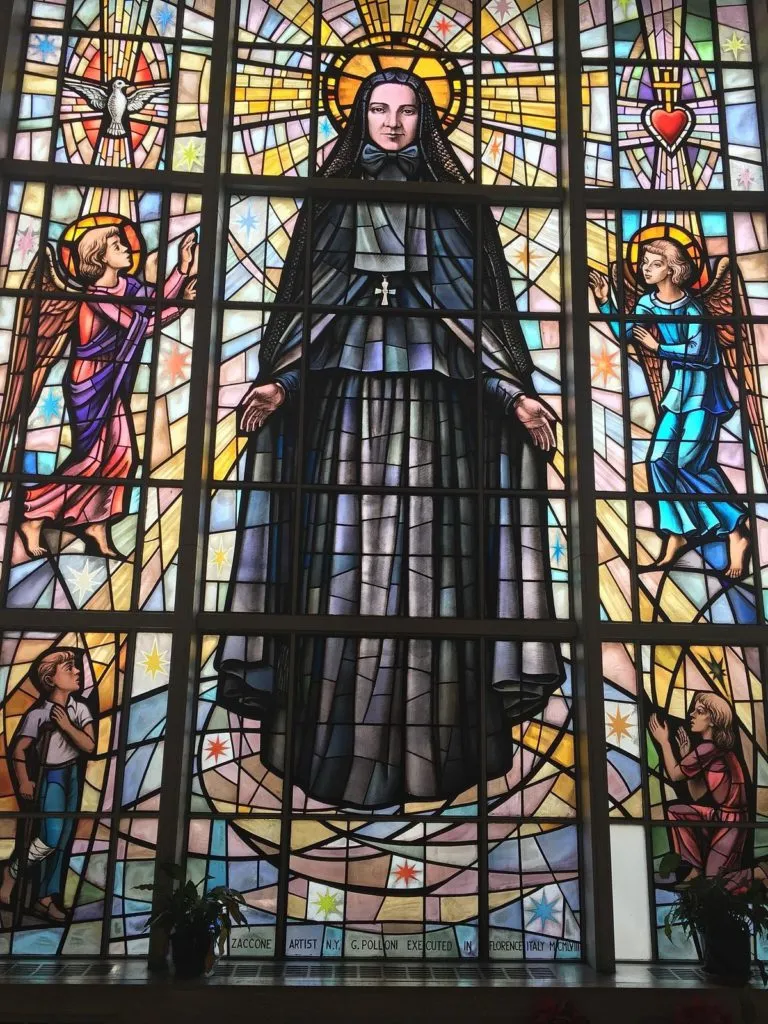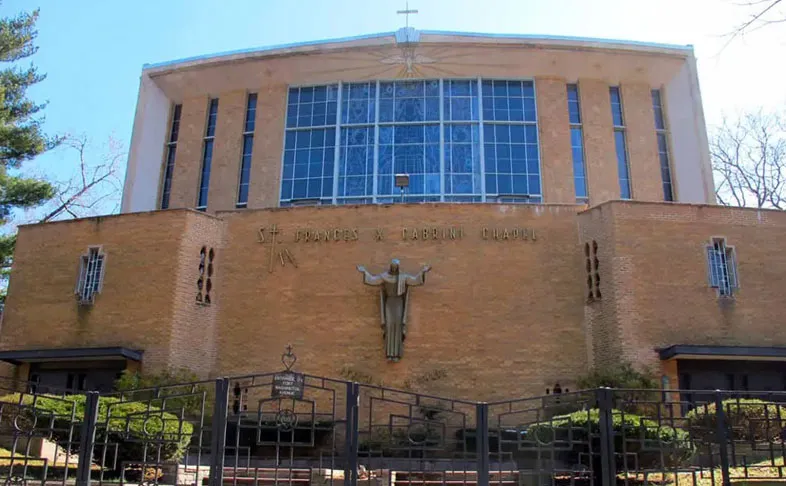
Introduction
The St. Frances Xavier Cabrini Shrine is located at 701 Fort Washington Avenue between Fort Tryon Park and West 190th Street, with a facade on Cabrini Boulevard, in the Hudson Heights neighbourhood of Washington Heights in Upper Manhattan, New York City. It is dedicated to Saint Frances Xavier Cabrini (Mother Cabrini, 1850–1917), who in 1946 became the first American citizen to be canonized by the Roman Catholic Church.
Mother Cabrini purchased the present shrine site in 1899. She bought it to house a boarding school for upper-class girls, and then used the tuition to fund orphanages and free schools for the poor. The buildings also acted as a receiving house for orphans. The U.S. novitiate for the Missionary Sisters of the Sacred Heart of Jesus, the order Mother Cabrini founded, was here as well.
Mother Cabrini always found great tranquillity when she visited this site. A bench upon which she liked to meditate remains for visitors to sit upon. In 1930 Mother Cabrini High School opened at 701 Fort Washington Avenue, and in 1933 her remains were translated (moved) to rest in the chapel of the school. Her heart is preserved in Codogno, Italy.
Five years later, at the time of her beatification in 1938, Mother Cabrini’s remains were placed in a glass reliquary beneath the altar of the school. And In 1959, the current shrine was constructed.

St. Frances Xavier Cabrini’s history is intertwined with the land that currently houses the Cabrini Shrine. In 1899, Mother Cabrini purchased the property to establish a boarding school for upper-class girls. The tuition from this boarding school was then used to fund orphanages and free schools for the poor. The buildings on the property also acted as a receiving house for orphans.
The US novitiate for the Missionary Sisters of the Sacred Heart of Jesus, the order which St. Frances Cabrini founded, was also established on this same property. Mother Cabrini found great tranquillity when she visited this site, and even today, visitors can sit on the bench upon which she liked to meditate.
After St. Frances Cabrini passed away in 1917 in Chicago, her remains were transported by train to New York and entombed on the grounds of Sacred Heart Orphanage in West Park, New York. In 1930, the Mother Cabrini High School opened at 701 Fort Washington Avenue, and in 1933 St. Frances Cabrini’s remains were translated (moved) to rest in the chapel of the school. Her heart is preserved in Codogno, Italy.
The flow of visitors to the school to pay homage to St. Frances Cabrini was staggering. Eventually, to accommodate all visitors, a separate building was built right next to the school, and that building now houses the Cabrini Shrine today. After the altar of the Shrine was consecrated, St. Frances Cabrini’s remains were translated to where she now rests.

The shrine was designed by the architectural firm of De Sina & Pellegrino as a horizontal parabolic arch. It includes prominent stained glass and a bright mosaic mural depicting Cabrini’s life, and personal mementos including her horse carriage.
The current entrance leads from a parking area into a small lobby. From this direction, one enters the shrine from a side door near the front of the sanctuary. The formal entrance is actually accessed from a staircase along Cabrini Boulevard but this entrance seems to be closed to the general public now.
This facade faces across the Hudson to New Jersey and presents a wealth of mid-century details in mosaics, metalwork, decorative brickwork and stained glass. Next door to the entrance of the Cabrini Shrine is a mid-century addition to Mother Cabrini High School. Given the colour of the brick and the metalwork, it is likely that De Sina and Pellegrino were also responsible for this addition.
When visiting the shrine, the interior should not be missed. Decoration includes colourful mosaics, inlaid floors, and an elaborate lighting fixture over the body of the saint. Some good images of the interior can be found here.
The Life of St.Cabrini
St. Frances Cabrini’s life began in northern Italy in 1850. As a young girl, Francesca Cabrini was enthralled by stories of missionaries. She loved playing by a river near her uncle’s house, filling paper boats with flowers – her “missionaries” — and sending them off down the river to China.
From a very young age Frances Cabrini knew she was called to be a religious. However, she was frequently sick. When she was old enough to enter a religious community, her requests to join were rejected. Disappointed but certain of her vocation, Frances received her teaching certificate. She taught in a nearby village school, and people soon noticed her ability to win over the children with love and kindness.
St. Frances Cabrini’s Early Religious Life

The town priest observed Frances Cabrini’s warmth, competence and faith. He mentioned the young schoolteacher’s unique qualities to the bishop of Piacenza. In 1874, the bishop asked Frances to become the administrator of an orphanage in Codogno. Frances’ organizational skills, tact, energy, and zeal were sorely needed there.
The orphanage was run by a fledgling religious community called the Sisters of Providence. Shortly after Francesca arrived, she joined the order. She took the name Saveria (Xavier) in honour of the great missionary who went to the Far East.
Though she was happy to finally enter religious life, this period of Frances Cabrini’s life was difficult. Her superior was jealous of and hostile toward the devout young nun. For six long years Frances Cabrini endured bullying and harassment. Her response was to draw closer to Jesus, to learn to trust Him more, and to draw all her consolation and comfort from Him.
“Give me the desire to humble myself for your love. Enlighten me how to do so when humiliating occasions present themselves. When I do not feel inclined to follow your holy inspirations, help me to do so.”
Under Francesca’s administration the House of Providence expanded. A Sunday school was added, as was adult education, work with local youth, and retreats for women.
Because of continued difficulties with the founders, the diocese dissolved the House of Providence in 1880. Francesca Cabrini was asked form a new religious order. Thus, at the age of 30, she set out to create the Missionary Sisters of the Sacred Heart of Jesus
Mother Cabrini’s Missionary Call
In the early years, the Missionary Sisters worked in northern Italy. But tiny Mother Cabrini – who stood barely 5 feet tall — was eager to spread the love of Jesus around the world. She still longed to go to China. Then a different opportunity presented itself.
In 1887 Mother Cabrini was approached by Bishop Giovanni Scalabrini. The bishop was deeply concerned about Italians who had emigrated to the Americas. In a single decade, nearly a million had fled poverty in southern Italy. Few had much education, and few possessed skills that allowed them to get good jobs. Instead of finding the better life they envisioned, they faced deep prejudice, poor wages, a padrone system of contract labour, and bad housing.
A report on emigrant conditions prepared for Pope Leo XIII described this environment as having “all the characteristics of a white slave trade.”2
In those days the U.S. was considered mission territory. There were few priests in the United States who spoke Italian. Bishop Scalabrini asked Mother Cabrini to go to New York to help.
St. Frances Cabrini Sets Sail
Mother Cabrini prayed about this deeply. Then she obtained an audience with Pope Leo XIII to seek his advice. The Pope told Mother Cabrini to go “not to the East, but to the West” to tend to the immigrants in the United States. So Mother Cabrini and six of her Missionary Sisters set off for New York City in 1889.
They found a mass of human misery: families crammed into foul tenements, parents working 12-hour days for meagre wages, and children who lacked food, supervision, and basic education.
Within days of her arrival, Mother Cabrini organized catechism classes and schooling for the children. She and the Sisters knocked door to door through rough neighborhoods, facing humiliating insults to gather funds to do their work. Their convent quickly became a haven for children from the notorious Five Points neighborhood. An orphanage was established, followed by parochial schools and a hospital.
The Mission Expands
Soon requests for Mother Cabrini’s help poured in from other cities in the United States, as well as from Europe and Central and South America. Renowned as a woman of deep faith, Mother Cabrini was also a shrewd businesswoman. Over the course of 34 years she established an astonishing 67 hospitals, orphanages, and schools. Her energy was fueled by an intense focus on serving Jesus in whatever he asked of her.
In Seattle in 1909 Mother Cabrini was granted citizenship in the United States. She died in Chicago on December 22, 1917 at the age of 67 of chronic endocarditis. She was canonized in 1946 by Pope Pius XII and became the first American citizen to be named a saint. Four years later she was given the title of Patroness of Immigrants.
In 1909 Mother Cabrini was granted citizenship in the United States. She died in Chicago on December 22, 1917 at the age of 67 of chronic endocarditis. She was canonized in 1946 by Pope Pius XII, becoming the first American citizen to be named a saint. Four years later she was given the title of Patroness of Immigrants.
Relics

Mother Cabrini died in Chicago in 1917 at the age of 67. Her body was transported by train to New York, and then entombed on the grounds of Sacred Heart Orphanage in West Park, New York. In 1930 Mother Cabrini High School opened at 701 Fort Washington Avenue, and in 1933 her remains were translated (moved) to rest in the chapel of the school. Her heart is preserved in Codogno, Italy.
Mother Cabrini’s remains were clothed in her religious habit and placed in a crystal coffin. A wax mask of her face and hands were placed over the relics to help pilgrims visualize her as she was on earth.
Before the casket was closed and sealed, the Missionary Sisters of the Sacred Heart and the girls from Cabrini High School were permitted to walk past it. Those who held rosaries were permitted to touch them to Mother Cabrini’s feet.
“The formalities completed, the heavy gold and glass was moved into place on top of the coffin so heavy sixteen men were required to bring it into the school – and Monsignor Natucci personally sealed the coffin, which will never again be opened.” (New York Herald Tribune September 14, 1938)
Five years later, at the time of her beatification in 1938, Mother Cabrini’s remains were placed in a glass reliquary beneath the altar of the school. St. Frances Cabrini was canonized on July 7, 1946. She was the first U.S. citizen to be proclaimed a saint. According to the New York Times, 45,000 people came to venerate her relics at the school on the day she was canonized.
When Mother Cabrini’s remains were exhumed prior to her beatification, they were found to be subject to normal decay with the exception of her heart, which is in a reliquary in Codogno, Italy. The glass reliquary in the altar at the Shrine contains her remains underneath her habit. Her face and hands are made of wax. The mask helps us see her as she looked when alive, even as we know she is alive in heaven.
First-class relics come from the body of a blessed or a saint. These may be bones, flesh, ashes, blood, hair, teeth, or even fingernails. Relics like these are normally collected when the body is exhumed as part of the beatification process. In most cases the body has naturally decomposed and bone fragments can be gathered easily. Tiny body fragments are called non-significant relics. Although they are sacred, they are considered too small for public veneration. A significant relic must be identifiable to the eye.
Second-class relics are items a saint used or touched: clothing, furniture, hairbrushes, writing utensils, glasses, books, and even vehicles. Even the instruments used to restrain or torture a martyr are considered second-class relics.
Third-class relics consist of anything that has been touched to a first-class or second-class relic. According to Canon Law, “It is permitted to reverence through public veneration only those servants of God whom the authority of the Church has recorded in the list of the saints or the blessed.” (Title IV, Can. 1187)
Artwork

A pictorial mosaic depicting scenes from Mother Cabrini’s life surrounds the altar. It is composed of Carrera marble, Botticino marble, and gilded Venetian glass. A towering three-story stained-glass image of Mother Cabrini at the back of the chapel overlooks the Hudson River. It features an unusual mid-century composition of pieced stained glass with painted details. A carriage Mother Cabrini drove when she visited West Park sits beneath the stained glass.
Miracles and Canonization
Mother Cabrini was declared Blessed in 1938, and became the first U.S. citizen to be entered into the Catalogue of Saints on July 7, 1946. The ceremony was the first to take place after World War II.
According to The New York Times, although 50,000 admission tickets were issued, demand exceeded supply. Rome was going through a heat wave so severe that the ceremony was cut short to four hours out of concern for the Pope, who wore heavy vestments. Photographs of the high altar show candles tilting and melting from the heat. The 75th anniversary of the canonization was marked on July 7, 2021.
Pipe Organ
The shrine is home to a pipe organ built by the Tamburini Organ Company of Crema, Lombardy, which features 2 manuals, 27 stops, 29 ranks, and 1,747 pipes. This and a similar organ in Chicago’s Cabrini shrine are rare instruments in the United States by this noted Italian organ builder from the region of Cabrini’s birth.
The organ in St. Frances Cabrini Shrine was built in 1960 by Giovanni Tamburini of Crema, Italy. It is installed in two chambers on opposite sides of the open gallery. The two-manual console is on a movable platform
Museum
The Shrine houses a small museum of second-class relics and memorabilia of Mother Cabrini. Rotating exhibits provide additional insight into her life and spirituality. A short video about the miracles leading up to Mother Cabrini’s canonization plays in English and Spanish. Pilgrims to the Shrine may, upon request, be blessed with a first-class relic of the saint.
Annual Feast Day
Annual Feast Day – 13th November.
The annual feast day of St. Frances Xavier Cabrini Shrine is celebrated on 13th November of each year.
Mass Timing
English
- Tuesday: 12:00 pm
- Wednesday: 12:00 pm
- Thursday: 12:00 pm
- Friday: 12:00 pm
- Saturday: 09:30 am
- Sunday: 09:00 am
- Sunday: 11:00 am
Spanish
- Sunday: 03.00 pm
- 4th Saturday: 02.00 pm
Contact Info
701 Fort Washington Ave. New York, NY 10040
Phone No.
Phone: 212 923 3536
Accommodations
How to reach the Sanctuary
Airways
The nearest airport to St. Frances Xavier Cabrini Shrine is New York Skyports Seaplane Base (NYS) Airport which is 3.5 miles away from the church.
Railways
The nearest Railway to St. Frances Xavier Cabrini Shrine is Pennsylvania Station which is 9.2 miles away from the church.








